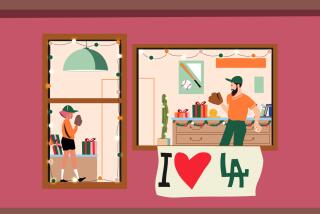AROUND HOME : LANDSCAPE : Terra-Cotta Pots
TERRA COTTA literally means âbaked earth.â So why do some terra-cotta pots cost up into the hundreds of dollars while others are in the $25 range?
There are several impostors of sorts--commoners masquerading as authentic and classic Italian craft.
What they all share is a warm, natural color and--for all but the plastic--an ability to let plants âbreathe.â
What is ârealâ terra cotta? Italian terra cotta is considered to be the most desirable--after all, the Tuscans have made it for centuries when stone was not readily available. They brought to this baking of native clay some of the elegance and sophistication we usually associate with northern Italian art.
Essentially, terra cotta is admired for its simplicity and longevity. High-firing clay in special kilns can give it the consistency of fine ceramic. Well-made terra cotta can last for a very long time--50 to 100 years--depending on its exposure to cold and heat. It does best in mild, even climates. Extreme temperature changes result in delamination--the surface begins to flake off, signaling its decline. All other conditions being the same, a pot in Santa Monica tends to last longer than one found in the San Fernando Valley, which in turn lasts longer than one in the Mojave Desert.
Beware of imitations--the Mexican clay pots, for example, which sometimes resemble the real thing. The cheaper Mexican pots are notorious for crumbling: They are sun-dried, without the strength high-firing gives. If you are lucky, they will last three to six years.
With a real terra-cotta pot, a milky patina develops as the clayâs natural lime and salts leech out with age. There are even those who coat their pots with buttermilk to mimic the natural aging process. Itâs something like bleaching your Leviâs or soiling your new white Reeboks.
The craze for classic European design here in Southern California has people looking afresh at terra cotta as garden sculpture. It almost always adds an un-Californian touch--pink flamingo itâs not. You can use terra cotta both formally, where potted citrus may flank a long pool, or haphazardly scattered in an informal herb garden. Hand-molded versus machine-made, locally produced versus imported, terra cotta tends to be expensive. Itâs like having a breath of Michelangelo in your garden--but you may prefer Diego Rivera.
The best selection of Italian terra cotta can be found at International Terra Cotta and Sculpture Design Imports in West Hollywood and Pottery Manufacturing & Distributing in Gardena . Many local nurseries have both Italian and domestic terra cotta. Look for them at Burkard Nurseries in Pasadena; Palos Verdes Begonia Farm in the Torrance area; Green Arrow Nursery in Sepulveda; Rogerâs Gardens in Newport Beach; Rancho Santa Fe Nursery in Rancho Santa Fe, and Turk Hessellund Nursery in Montecito, and through the Smith & Hawken catalogue in Mill Valley--telephone (415) 383-6292.






